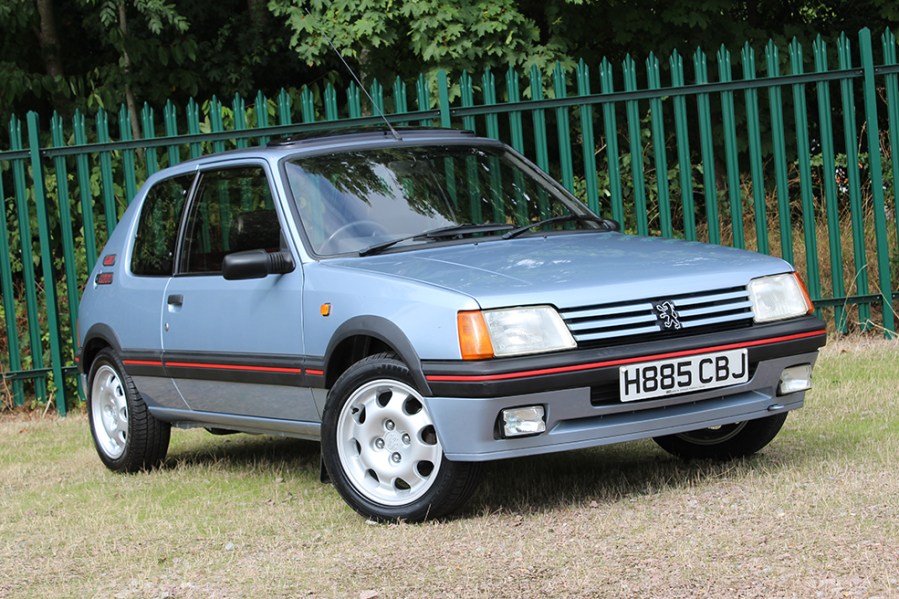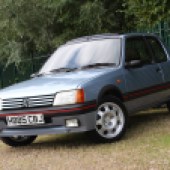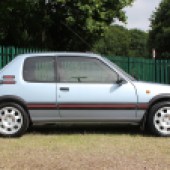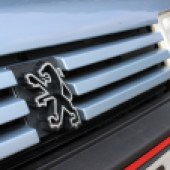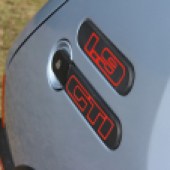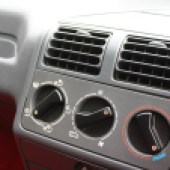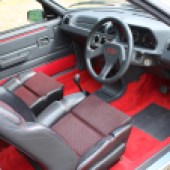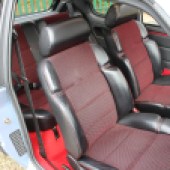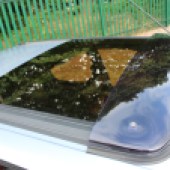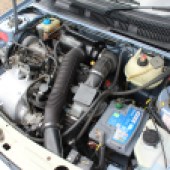The Peugeot 205 GTi is one of the all-time great hot hatchbacks whose values have risen dramatically in the past few years. Here’s how to buy one
The launch of the Peugeot 205 in February 1983 marked a major change of direction for the French motor manufacturer, which over the years had gained a reputation for producing a range of unexciting but very capable family saloons and load-lugging estate cars. Peugeot’s rather conservative image was finally put to rest with the arrival of the 205: a small, stylish front-wheel drive, three-and five-door hatchback that set new standards in chassis dynamics and was reasonably cheap to buy and own.
Detractors of the marque may even go as far to claim the 205 GTi was the last decent hot hatch Peugeot ever made, as when the three-door 1.6-litre version arrived on the scene in 1984, this little firebrand set the small performance car market alight almost overnight. Although the press raved about the car’s performance and handling capabilities of the ‘hot’ 205, period road tests also heaped an almost equal amount of praise on the 954cc powered entry-level models. Full order books for the new 205 helped improve the French carmaker’s flagging finances and a few months after it was launched, the 205 narrowly lost out on the European Car of Year award to the Fiat Uno.
The development of the 205 can be traced back the late 1970s and Peugeot’s acquisition of Simca in 1978. Prior to the takeover, Simca had gained a huge amount of experience building small cars and this knowledge was used to refine the replacement for the Peugeot 104. Early 205’s were fitted with the X or Douvrin ‘suitcase’ engine, which had its transmission in the sump. It didn’t take long, however for this engine to be superseded by the PSA developed XU and TU single and double overhead camshaft units available across the 205 range with a swept volume ranging from 954cc to 1905cc.
The 1.6-litre 205 GTi was powered by a 1580cc single overhead cam eight-valve, engine capable of punching out a very useful 104bhp at 6250rpm. What made the 205 GTi so special was its finely tuned chassis, which made the little Peugeot more entertaining to drive than the more powerful Renault 5 Turbo. The GTi’s 185-width tyres put down enough grip to make sliding through corners on a trailing throttle more than interesting. Lift off the throttle in mid corner though and you could be in trouble. Driven properly, the 205 GTi was hoot to drive and its communicative steering combined with McPherson front struts and a compact trailing arm/torsion bar suspension setup at the rear made the performance version of 205 hatchback respond like a real sports car.
In late 1986, Peugeot upped the anti with the introduction of the 130bhp 1.9-litre 205 GTi. The revised model’s naught to 60mph time now came up in a very respectable eight seconds and tweaks to the suspension reduced the earlier model’s pitch and roll, albeit at the expense of passenger comfort. A tendency for the performance 205 to understeer while being pushed hard was addressed on the revised model, although some enthusiasts still consider the earlier model’s balance between handling and power was slightly better than the more powerful 1.9-litre GTi.
A Pininfarina-designed soft top 205 joined the line up in 1985 and heading the convertible line up was the 1.9-litre CTi. A popular misconception is that the Italian styling house was responsible for penning the 205’s lines, but that honour goes to Gérard Welter and interior stylist Paul Bracq. During the 205’s 15 year production run, the exterior styling was never seriously updated, although the interior was revamped for the 1988 model year.
Peugeot 205s fitted with the company’s ultra smooth 1769cc or 1905cc PSA XUD oil burning engines converted many owners to the back art of diesel power and the final Peugeot 205 rolled off the production line in 1998 after over five million of these excellent little cars had been built.
Bodywork
The first thing to do when inspecting the bodywork is to look carefully for any overspray on window rubbers that could indicate any recent body repairs. Check all the shut lines around the bonnet, doors and tailgate. They should be even all the way round each panel and odd gaps will indicate a poor repair. The gauge of the metal used on the 205’s body is very thin and any dings or dents will stand out like a sore thumb. Take a moment to squat down beside each headlight and look along the line of the car to check the condition of the panels.
Pay particular attention to the area below the fuel filler cap, as a heavy front shunt may have caused the rear panels on a 205 to distort. Rust will attack the 205’s body in all the usual places and the main area to check is the seam between the sill and the lower part of the rear wing. All four wheelarchs on a 205 are susceptible to corrosion and the part of sills behind the front wheels and just in front of the rears can also rust out.
On neglected examples, rust can start behind the windscreen rubbers and eat it way into the roof and front scuttle. With the bonnet raised, inspect along the inner wings and down behind the headlights for signs of corrosion. If possible, ease the carpets up in each footwell and check for any corrosion in the floor pan, especially along all the seams and do the same in the boot.

Engines
When looking around the 205’s engine bay check for any major oil leaks and pull the filler cap off the rocker cover while the motor is running to check for any blue smoke. This could indicate worn valve seals, a problem that can often affect GTi engines around the 60,000 miles mark. While the cap is off, check for any signs of a mayonnaise-type gloop underneath the rocker cover as this could indicate coolant contaminating the engine oil through a blown head gasket, especially on the 1.9 unit.
The cambelt and camshaft end seals on all 205 XU engines should be changed every 36,000 or three years to be on the safe side, so look through the car’s service history and check with the owner if this has been carried out. It’s also important to change the coolant in diesel-powered 205’s every two years to avoid any cylinder head gasket problems and petrol-powered cars will also benefit from a regular radiator flush and a fill of fresh anti-freeze.
Early 205’s have their gearbox in the engine’s sump, so ensure the oil has been changed regularly by checking the service history and mileage carefully. High mileage petrol engines can get a bit smoky but it’s nothing to worry about providing the main crankshaft bearings aren’t rumbling away while the car’s idling. Worn big end bearings will make themselves heard on the overrun and don’t forget to check the engine idles smoothly when a full electrical load (lights, wipers and heater blower) has been applied.
If a 205’s engine stalls frequently, check there’s not an air leak on the throttle body or the sealed breather tube isn’t blocked with oil sludge. Over enthusiastic use of a spanner or socket set while replacing auxiliaries on a 205’s aluminium engine may strip threads, so make sure there’s no missing bolts and always use a torque wrench when working on the car. Any fuel injection issues with the 205 should be addressed by a specialist with the correct diagnostic equipment, but don’t worry if a 1.9 GTi is a little lumpy on start up as this is quite normal.
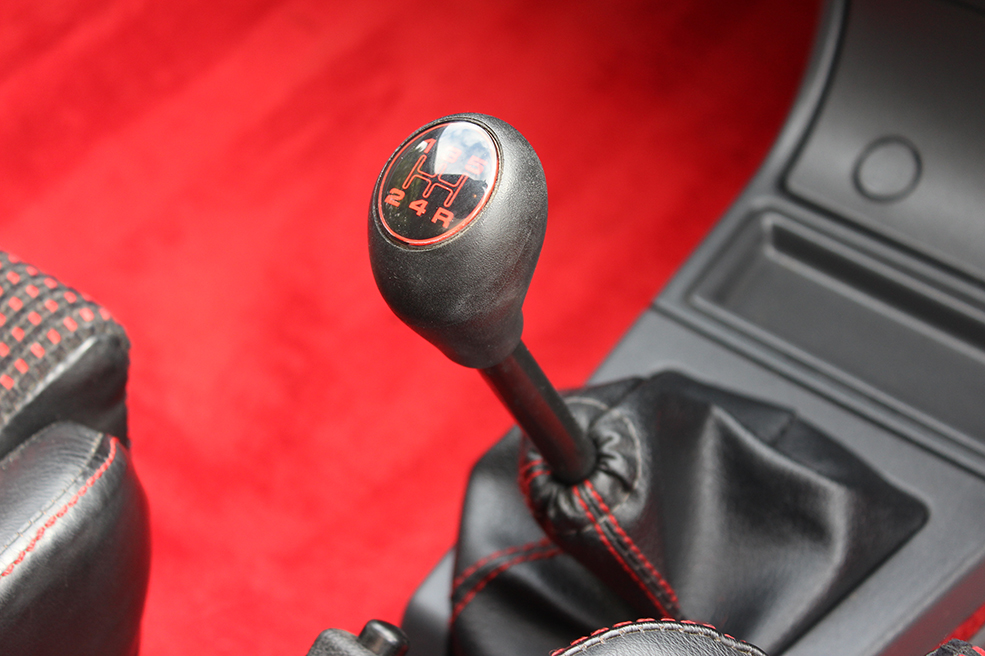
Transmission
The 205’s five-speed cogbox is reasonably bullet proof but worn synchromesh on second or third ratios may be evident on high mileage cars. When the car is cold, the gearchange can be rather stiff and this isn’t helped when the clutch cable starts to seize up. This will produce a heavy clutch pedal and will make the car unpleasant to drive. Replacement cables are readily available and can be easily fitted by an experienced DIY owner. If the gearchange remains stiff when the car’s warmed up, suspect damage to the linkage and this issue will need to be fixed as soon as possible as the mechanism won’t take too much heavy handed use.
Early 205s have the gearbox located in the sump and to access the gears and selectors, the engine will have to come out and the crankcase split. Later models have their gearboxes mounted on the end of the transversally mounted engine and the ‘box can be removed from underneath the car. A knocking noise on the move which remains constant when the steering wheel is turned rules out worn CV joints and could be caused by a differential bearing about the give up the ghost. This should be attended to promptly as if the does bearing break up it could seriously mangle the transmission casing.
Suspension, steering and brakes
If the steering wheel starts to shimmy and shake as the car approaches the legal limit, this could mean that as well as the front wheels being out of balance, a suspension component, such as worn wishbone bushes could be adding to the cause. Before taking a test-drive, turn the steering from lock to lock while the car is stationery and check for any clunks from the front suspension. Bottom ball joints can wear out and worn anti-roll bar drop link bushes can also soften up the steering.
Test the condition of the shock absorbers by bouncing each corner of the car – it should level out after one and half bounces. Any knocks or bangs from the rear of 205 while on the move is bad news. This could indicate the bearings in the trailing arms are worn and replacing these items can be very expensive. The steering rack (power on some models, so inspect the condition of the pump and pipes) has a hard life as the steering is heavy but replacements are readily available and fitting a new rack is a relatively straightforward job.
Pressing the brake pedal hard from high speeds on a 205 should pull the car up squarely without too much fuss or pulling to one side. The servo is very responsive and very heavy braking may cause the front wheels to lock up. Check all the brake lines for corrosion or leaks and if possible, ask the owner to remove the wheels to inspect the condition of the front discs.
Rear discs on the GTi are susceptible to corrosion and if the discs look in to be in poor shape, its odds on the calipers are past their best too. Replacement braking components are relatively cheap and easy to fit, so don’t be put off if this is all you can find wrong with the car you’re looking at. Early diesel powered 205s had small front discs, but these may have been uprated to larger ones by a previous owner.
Alloy wheels, especially on the GTis, can be easily kerbed, so check each wheel carefully for any damage or corrosion around the rim or stud holes, as refurbishing alloy wheels can be expensive when the cost is multiplied by four. While checking the condition of the wheels, have a good look at the state of the tyres, don’t forget to see if the spare wheel is where it should be in its cage underneath the boot. Having to replace a set of worn tyres or sourcing a stolen spare wheel can be a useful bargaining tool when it comes to negotiating the price of the car.
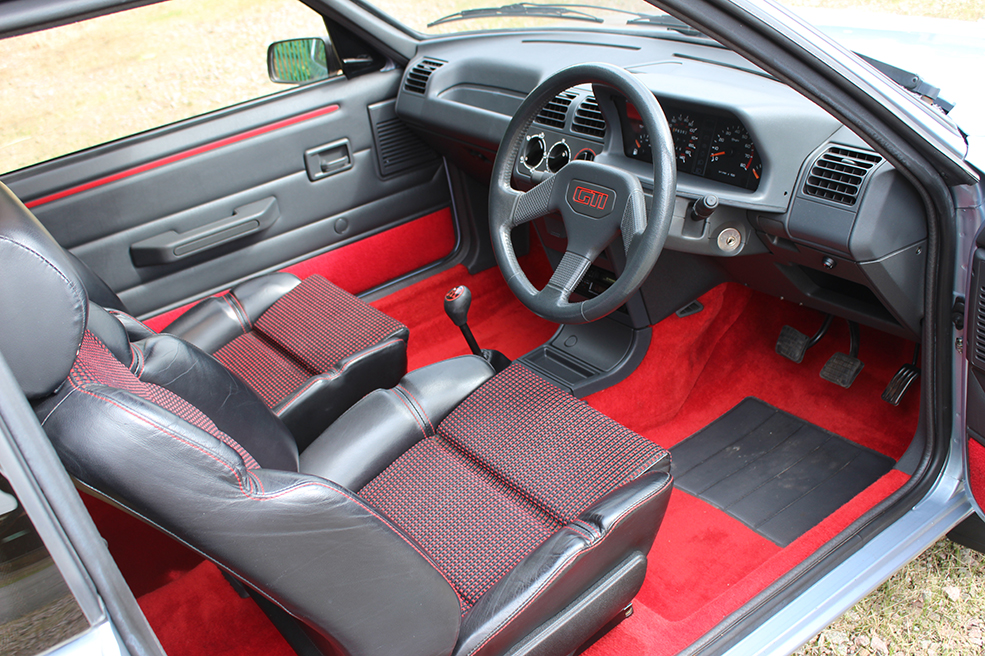
Interior
Don’t be put off if the interior rattles and creaks on the 205 you’re looking at. This is quite normal as the quality of the plastic trim is very basic. Most cars will have had a pair of speakers mounted into the rear parcel shelf and finding an unmolested shelf minus holes is a bit like searching for the Holy Grail. The side bolster on the driver’s seat can wear out, but a good trim shop should be able to stitch in new panel to repair the damage if the rest of the seat is okay.
However, the cloth seat facings on early cars can wear out quite quickly and finding replacements in good condition is almost impossible. Some cars may have been fitted with an all leather interior from a scrapped limited edition 1.9 GTi –not a problem unless originality is high up on your list.
The 205’s sunroof can be problematic as the seal is pressurised through a tube to keep the glass in contact with the seal. Releasing the handle relieves the pressure and allows the sunroof to slide more easily. Raising the handle fills the seal with air, so a damaged seal will cause the sunroof to leak. Desirable options were electric windows and central locking and these items may have been retro fitted at some point during the car’s life.
Peugeot 205 GTi: our verdict
Having enjoyed a meteoric rise to classic car status, the 205 GTi has shaken off its boy-racer image and secured plenty of interest from enthusiasts and collectors alike. A great example will not only offer one of best hot-hatch experiences ever, but should also hold its value well over the coming years – and perhaps even turn a tidy profit should you be so inclined later on.
Where the similarly popular Mk2 Golf GTI is the more solid, sensible choice, the 205 is a sharper, more engaging proposition for those who enjoy a more sprightly driving experience. Values for the best examples are best described as astronomical, but there are still some attainable rolling projects around.

